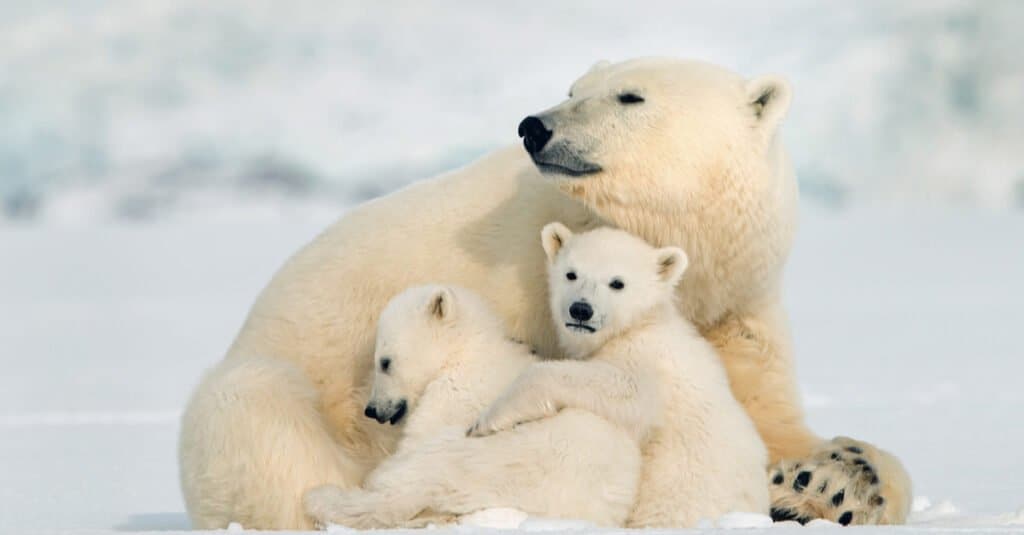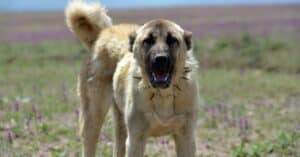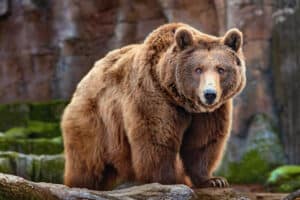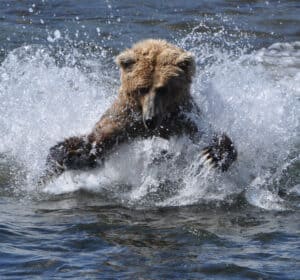Bears look deceptively friendly and touchable with their abundance of fur and their slow, ambling gait. That most famous of bears, Winnie the Pooh, is partly to blame for this image. But as everyone knows, one of the most terrifying creatures on earth is a mother bear protecting her cubs. Whether she’s preparing to give birth or sheltering her young from predators, she makes a fearsome adversary! How long are bears pregnant, and how many cubs can they expect to nurture to adulthood? Find out this and more below!

Most bears are pregnant for a period of 6-8 months, though it varies according to species.
©isabel kendzior/Shutterstock.com
Types of Bears
Bears are large, furred mammals belonging to the Ursidae family. There are 8 species of bears in the world, each with its own subspecies. Six of these species are endangered.
North American Black Bear (Ursus americanus)
The North American black bear is the most common type of bear in the world. This species branches out into 16 subspecies, including the California black bear and the cinnamon bear. True to its name, it lives only in North America.
Most of these bears are black in colour with a couple of notable exceptions. The cinnamon bear, for example, is cinnamon-coloured. The Kermode bear, or spirit bear, is white; despite popular misconception, this is not the result of albinism. It’s a genetic mutation known as polymorphism and may provide an advantage during salmon hunting.
These are highly versatile animals with the ability to adapt to a number of new environments. Because of their adaptability, scientists classify them as a species of Least Concern.
Brown Bear (Ursus arctos)
The brown bear or grizzly bear is another well-known North American animal, though it also lives in Europe and Asia. Renowned for its fearsome hunting abilities, it is a symbol of fierce strength and independence.
These bears are usually brown in colour, ranging from very dark to very light. Kodiak bears are the largest brown bear subspecies and the second largest type of bear in general, second only to the polar bear.
Polar Bear (Ursus maritimus)
Polar bears are the largest bears in the world. Unfortunately, they have a reputation for hunting humans. These white bears live in the Arctic and are scattered throughout Alaska, Canada, Greenland, Norway, and Russia. They rely heavily on the presence of ice for hunting seals. As the Arctic ice melts, their habitat gets smaller and smaller. For this reason, polar bears are considered endangered.
Giant Panda Bear (Ailuropoda melanoleuca)
The giant panda bear is a worldwide symbol of conservation. With its distinctive black and white markings, it is one of the most recognizable bear species. Unfortunately, it’s also one of the most endangered. Habitat loss has limited its home to 6 areas in Western China.
Pandas eat little else but bamboo. They have a special “thumb” adapted for this purpose. They have to eat up to 20 kilograms of bamboo per day to satisfy their nutritional needs.
Asiatic Black Bear (Ursus thibetanus)
Asiatic black bears or moon bears are divided into 7 subspecies, all living exclusively in Asia. They are an endangered species due to hunting and habitat loss. Black fur and a white crescent patch on their chests are their distinguishing features. They tend to be more carnivorous than North American bears.
Sloth Bear (Melursus ursinus)
Sloth bears are smaller than most other bears. There are only 2 subspecies: the Sri Lankan sloth bear and the Indian sloth bear. They are vulnerable to extinction due to hunting and habitat loss. They can be confrontational with humans, which has led to hunters trying to exterminate local populations. Sloth bears are dusty black with a white V on their chests.
Spectacled Bear (Tremarctos ornatus)
The spectacled bear or Andean bear lives exclusively in the South American Andes Mountains. They are the only living species of short-faced bears. These bears derive their name from the white and black markings on their faces, which resemble spectacles. They are endangered and often hunted as livestock pests.
Sun Bear (Helarctos malayanus)
The sun bear is the smallest bear species in the world and is native to Indonesia and Malaysia. Their fur is black or brown with yellow chest crescents. Though they aren’t exclusively carnivores, they have the largest tooth-to-mass ratio of any living bear species. Because of their love for honey, people also call them honey bears. This species is endangered with only 2 subspecies.

Female bears give birth every 2-4 years. They usually mate in May or June, though some enter heat again in July or August.
©Debbie Steinhausser/Shutterstock.com
Bear Appearance and Size
Bears range in colour from white to yellow to brown to black. Some have white markings on their chests while others have white and black markings on their faces. Generally, they have shaggy fur, sharp claws, and teeth engineered for ripping and tearing.
The largest bear in the world is the polar bear. They can grow up to 8-10 feet in length and measure 4-5 feet at the shoulder, weighing as much as 800-1,300 pounds. The biggest polar bear on record stood 11 feet 1 inch on its hind legs and weighed 2,209 pounds!
The smallest bear in the world is the sun bear. They typically only weigh 55-145 pounds with a body length of 4-5 feet.
Bear Diet and Predators
Bears are omnivorous, eating both plant and animal matter. Common food sources are roots, berries, honey, grain, insects, fish, and birds. They may also eat deer, caribou, elk, moose, or various small mammals. Polar bears subsist largely on seals while panda bears stick to bamboo. Some bears will also seek out human food and garbage.
Bears have few predators. Other bears may occasionally pose a threat, though humans remain their top concern. However, bear cubs may be the targets of wolves, coyotes, and big cats.
Bear Habitat
Bears live throughout North America, Europe, and Asia with a small number in South America. They are adaptable, making their homes in grasslands, forests, tundra, mountains, and deserts.
Bear Social Behaviour
Bears are generally solitary animals. They defend their territories aggressively against other bears and humans. The only exceptions are mating times and mothers with cubs. Male bears dominate in any social setting; mothers with cubs rank higher than young males and females without young.
Bear Reproduction and Lifespan
Bears mature sexually at 3-5 years. One male may mate with a number of females; less dominant males may not mate at all. Females may also accept the advances of a number of males. The male and female in question remain in close proximity during the courtship and mating process.
Bears generally live from 15-30 years depending on their species, though some have lived as long as 45 years in captivity. Giant panda bears typically live the shortest lives of all the bear species. Brown bears and polar bears are the longest-lived on average.
How Long Are Bears Pregnant?
Bears are usually pregnant for 6-8 months. However, gestation time varies according to the type of bear. Gestation times for the 8 different species are as follows:
- North American Black Bears: 220 days
- Brown Bears: 180-250 days
- Polar Bear: 195-265 days
- Giant Panda Bear: 95-160 days
- Asiatic Black Bear: 200-240 days
- Sloth Bear: 210 days
- Spectacled Bear: 160-255 days
- Malayan Sun Bear: 95-240 days

Bears give birth to litters of 1-4 cubs. These cubs remain with their mother for 1-2 years.
©iStock.com/USO
How Can You Tell If a Bear is Pregnant?
Pregnant bears will begin to gain weight, storing extra fat as they prepare to give birth. It can be difficult to make a definite determination as bears are generally rotund and carry a lot of fur. In captivity, an ultrasound test is the best way to determine whether or not a given bear is pregnant. Some zoo owners have also had success analyzing the chemical content of bear stools.
How Often Can a Bear Get Pregnant?
Female bears usually go into estrous, or heat, in May or June. Some will experience a second cycle in July or August. They reach maximum fertility during a 3-5 day period, though their cycle lasts a number of weeks. They typically only bear one litter every 2-4 years.
Bear Litter Size
Bears usually give birth to 1-4 cubs at a time. Mothers wean their cubs at 6-8 months, though they will remain with her for the first 1-2 years of their lives. Mother bears are very devoted to their cubs, so the eventual separation can be painful. Cub siblings often stay together for a while after leaving their mother.
In general, if you suspect a bear is pregnant or see evidence of cubs, stay far away!
Thank you for reading! Have some feedback for us? Contact the AZ Animals editorial team.








